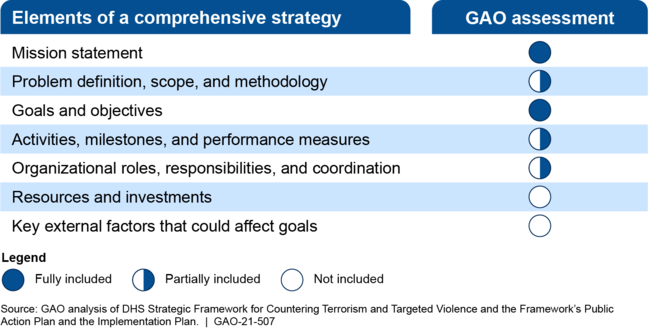Countering Violent Extremism: DHS Can Further Enhance Its Strategic Planning and Data Governance Efforts
Fast Facts
There were 81 fatal violent extremist attacks in the United States from 2010 through 2020, resulting in 240 deaths, according to an academic database that tracks extremist crime.
We reviewed the Department of Homeland Security's strategy for preventing targeted violence and terrorism, including its efforts to counter violent extremism.
DHS's strategy didn't include all 7 elements of a successful strategy, such as a resource assessment for carrying it out. DHS could also do more to ensure it's gathering and able to use quality data to evaluate the success of its strategy.
We made 3 recommendations to address these issues and more.

Highlights
What GAO Found
DHS's 2019 Strategic Framework for Countering Terrorism and Targeted Violence and the related plans—collectively referred to as the strategy—outline the department's vision for all DHS counterterrorism activities. In prior work, GAO has identified seven elements of a comprehensive strategy. GAO found that DHS's strategy contains some but not all of the key elements (see figure). For example, GAO found that DHS's strategy included a mission statement, and a set of goals that were in turn linked to objectives and priority actions. However, the strategy did not include a discussion of external factors such as how the economy, demographics, or emerging technologies may affect the department in meeting its goals. By identifying and assessing such external factors, DHS would be better positioned to proactively mitigate such factors or plan for contingencies, if needed.
Extent to Which DHS's Strategy for Countering Terrorism and Targeted Violence Included the Seven Elements of a Comprehensive Strategy

DHS has taken some steps to establish a data governance framework, which helps ensure that an agency's data assets are transparent, accessible, and of sufficient quality to support its mission. For example, DHS established a data governance council to manage various data priority areas, however it has not yet completed actions to include targeted violence and terrorism prevention data into its department-wide framework. DHS has already identified some data challenges, such as the lack of comprehensive, national-level statistics on terrorism and targeted violence that underscore the need for a data governance framework. By incorporating targeted violence and terrorism prevention data into its broader data governance framework, DHS would be better able to leverage data to support and inform its prevention efforts, including building effective policy to address the threats and trends it identifies in the data.
Why GAO Did This Study
Data collected through the Extremist Crime Database show that there were 81 fatal violent extremist attacks in the United States from 2010 through 2020, resulting in 240 deaths. Since 2010, DHS has developed strategic initiatives that address targeted violence and terrorism prevention, which include efforts to counter violent extremism, among other things. GAO was asked to review DHS's longer-term efforts to prevent terrorism and targeted violence.
This report examines the extent to which (1) DHS's 2019 strategy to address targeted violence and terrorism prevention includes key elements of a comprehensive strategy, and (2) DHS has developed a data governance framework to help implement its strategy. GAO reviewed DHS documentation and compared DHS's strategy to identified elements of a comprehensive strategy, and compared DHS's efforts to develop a data governance framework to federal requirements for implementing data governance.
Recommendations
GAO is making three recommendations, including that DHS revise its strategy to include all key elements of a comprehensive strategy, and incorporate its targeted violence and terrorism prevention mission into its departmental governance of data.
Recommendations for Executive Action
| Agency Affected | Recommendation | Status |
|---|---|---|
| Department of Homeland Security |
Priority Rec.
The Secretary of Homeland Security should ensure that the Office of Counterterrorism and Threat Prevention Policy and affected components and offices revise or supplement DHS's Countering Terrorism and Targeted Violence strategy to include all key elements of a comprehensive strategy. (Recommendation 1) |
DHS took steps to augment information contained in its 2019 Countering Terrorism and Targeted Violence Strategy to include additional key elements of a comprehensive strategy. The 2019 Strategy has been superseded by a combination of more recent strategies and other initiatives, including the 2021 National Strategy for Countering Domestic Terrorism and the 2022 Memorandum on U.S. International Counterterrorism Policy. In 2023, DHS completed a comprehensive assessment of all relevant strategies to consolidate and prioritize the department's critical counterterrorism action items. Through this assessment, DHS incorporated additional key elements of a comprehensive strategy that were not included in the 2019 Strategy, such as identifying needed resources and external factors that could affect goals. By taking these actions, DHS is better positioned to make informed decisions about its counterterrorism efforts, including setting priorities, allocating resources, and identifying program improvements when needed. We consider this recommendation closed as implemented.
|
| Department of Homeland Security |
Priority Rec.
The Secretary of Homeland Security should ensure that the Chief Data Officer—in consultation with other affected offices and components—incorporates the governance of data needed to support DHS's targeted violence and terrorism prevention mission into its departmental data governance framework, including determining how targeted violence and terrorism prevention will be represented on the data governance body, conducting a data maturity assessment, and identifying opportunities to increase staff data skills that includes targeted violence and terrorism prevention data. (Recommendation 2) |
DHS concurred with the recommendation and has taken steps to incorporate planned data collection into its data governance framework. For example, in March 2024, the department identified the data domains that would govern targeted violence and terrorism prevention data. In addition, DHS published a 2024 departmentwide learning agenda, which is a mechanism to capture DHS skills and capabilities required to meet mission goals, including those associated with targeted violence and terrorism prevention. For this mission, DHS identified needed skills such as conducting quantitative surveys, qualitative interviews, and focus groups. Further, as of June 2024, DHS has conducted a data maturity assessment across all department missions, including targeted violence and terrorism prevention. This data maturity assessment considered elements such as the department's data governance, security, sharing, and analytics, among others. By taking these actions, DHS is better positioned to leverage data to support and inform its targeted violence and terrorism prevention efforts, including building effective policy to address threats and trends it identifies in the data.
|
| Department of Homeland Security |
Priority Rec.
The Secretary of Homeland Security—in consultation with affected offices and components—should establish common terminology for targeted violence. (Recommendation 3) |
DHS concurred with this recommendation. In March 2024, DHS provided a draft definition of targeted violence. DHS officials stated they were working with stakeholders to finalize the definition. As of February 2025, DHS officials stated that the draft terminology was still under review and anticipated that the definition would be finalized and published by September 2025. We will continue to monitor DHS's progress.
|
